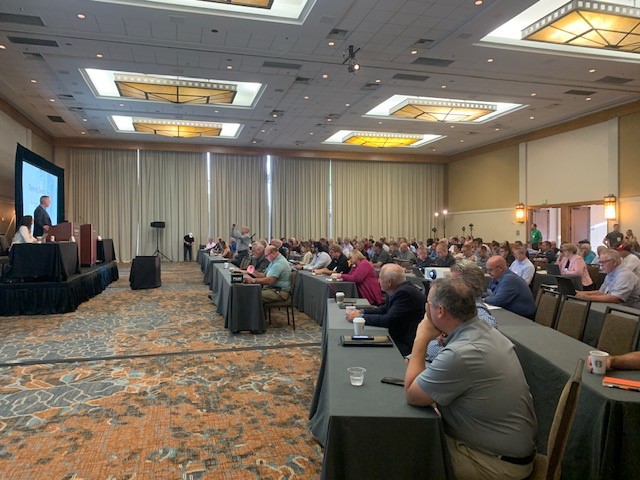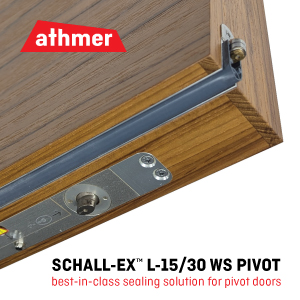FGIA Fall Conference Offers Updates on Energy Star 7.0, Product Certifications, Codes, and More

Attendees of the Fenestration & Glazing Industry Alliance 2023 Fall Conference gathered at The Westin Westminster outside of Denver last week for three days of task group and committee meetings, industry-wide updates, networking and more.
Atop the agenda were notable regulatory changes that will impact industry manufacturers, including Energy Star 7.0 requirements, which go into effect in less than a month. The conference also provided a look at code updates, including discussion on adding climate resiliency to the codes, changes at OSHA, and a presentation on the role indoor air quality plays in environmental justice.
Energy Star 7.0 is coming Oct. 23
After years of development and planning, Energy Star 7.0 goes into effect Oct. 23, said Kathy Krafka Harkema, FGIA U.S. technical operations director during her regulatory and legislative report at the conference.
The U.S. Environmental Protection Agency finalized the Version 7.0 Energy Star Specification for Residential Windows, Doors and Skylights in October 2022, and this new update is the result of a four-year collaboration between EPA, the U.S. Department of Energy and Lawrence Berkeley National Laboratories that involved modeling the energy characteristics of a range of high-performing windows in different operating conditions. Learn about the new regulations and how they will impact the industry.
Will Colorado require Energy Star windows?
In June, the HP23-1161, the Appliance Standards Bill with environmental standards for certain products, passed in Colorado with additional requirements for residential windows, doors and skylights. The law, which would go into effect next year, mandates new products sold into Colorado meet higher performance standards. For windows, doors and skylights, the law calls for products that are Energy Star-rated for the Northern climate zone. During the conference, Jeremy Neustifter of the Colorado Department of Public Health & Environment, provided an update on the new law and fielded questions.
Numerous commenters at the conference expressed concern that the law is moving more aggressively than the building codes, in terms of product performance. “Is this law trying to circumvent the energy codes?” asked one attendee.
Commenters also expressed concern over enforcement and fines for noncompliance, and over costs to manufacturers and customers. “This will limit options of products to consumers. Cost is a factor, too,” said another attendee.
The law currently affects only residential fenestration products. Neustifter says it’s “up to the legislature” whether it will move to commercial products.
Following the presentation, Krafka Harkema noted, “our position is that Energy Star [products] should be the most efficient, and codes should be below that.” She continued, “this is the beginning of our dialogue,” and said that FGIA would be actively involved and following the situation in Colorado to help prepare the industry for changes on the horizon.
How will Energy Star 7.0 Affect IG Certification?
During FGIA’s certification programs update, Jason Seals, FGIA certification services manager, addressed a potential challenge to manufacturers once Energy Star 7.0 goes into effect.
Per Seals, the association began to allow extensions of certification in 2015. “In 2018, we started allowing those reports to be extended more than once,” says Seals. “But this creates an issue with Energy Star and air-leakage reports. Sometimes that forces the manufacturer to go back to the lab.”
He advised manufacturers to take note of the dates of their air-leakage reports to avoid a bottleneck with Energy Star.
Read more from the certification update.
Is climate resiliency coming to the building codes?
Krafka Harkema and Amy Roberts, FGIA director of Canadian and technical glass operations, also offered code updates for the U.S. and Canada. Both noted the potential for new code requirements that look to better protect buildings against the threats of climate change.
One question from Krafka Harkema: How will recent deadly and destructive wildfires affect building codes? Will we begin to see codes that call for products designed to better resist fires? “We can anticipate following that massive tragedy in Hawaii that we will see code changes,” she said.
The Canadian government is also implementing programs to address the effects of climate change in buildings and to fight climate change, said Roberts. One area of focus that could impact the glass and fenestration industries is a move to improve climate resiliency of the built environment, she said.
Additionally, the Canadian government has been focused on reducing carbon emissions in buildings and is expanding the scope to address embodied carbon in the built environment.
New OSHA requirements take closer look at PPE
On the regulatory front, Krafka Harkema also noted a few changes at the Occupational Safety and Health Administration that could affect industry manufacturers. One change of note: OSHA is planning to allow third parties on inspections, she said.
Additionally, OSHA is looking at new requirements for PPE. “PPE must fit properly, and OSHA inspectors will be enforcing that,” from masks, sleeves, gloves and more, Krafka Harkema said. “Make sure that your workers are safe and that their personal protective equipment fits properly, and that you have a range of sizes,” she said.
Study shows fenestration plays role in improving indoor air quality
Participants at the Fall Conference learned about the role those in the industry can play in helping reduce pollutants in the indoor spaces of those living and working in communities that have been disproportionately affected by construction projects. Nicholas Clements from the University of Colorado Boulder gave a presentation, “The Role Indoor Air Quality Plays in Environmental Justice Communities Impacted by Construction.”
Ventilation can play a large role in improving indoor air quality, Clements said. “Ventilation and infiltration can include options like using fans, a form of mechanical ventilation, or opening windows, a type of natural ventilation.”
Next up
FGIA will gather next in Amelia Island, Florida, Feb. 19-22 for the organization’s Annual Conference. Learn more at fgiaonline.org.

